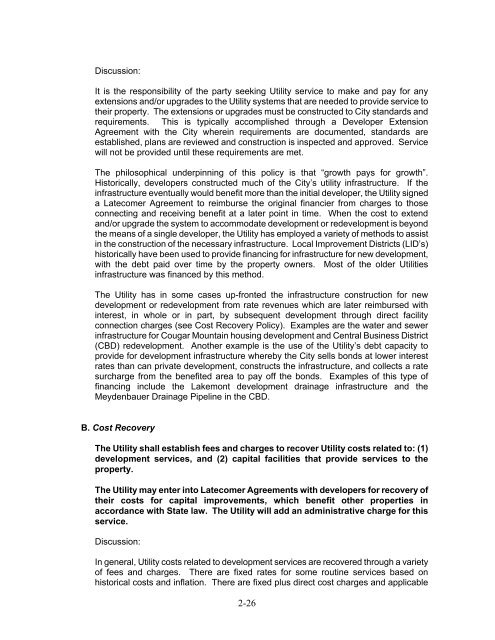2006 Water Comprehensive Plan - City of Bellevue
2006 Water Comprehensive Plan - City of Bellevue
2006 Water Comprehensive Plan - City of Bellevue
- No tags were found...
Create successful ePaper yourself
Turn your PDF publications into a flip-book with our unique Google optimized e-Paper software.
Discussion:It is the responsibility <strong>of</strong> the party seeking Utility service to make and pay for anyextensions and/or upgrades to the Utility systems that are needed to provide service totheir property. The extensions or upgrades must be constructed to <strong>City</strong> standards andrequirements. This is typically accomplished through a Developer ExtensionAgreement with the <strong>City</strong> wherein requirements are documented, standards areestablished, plans are reviewed and construction is inspected and approved. Servicewill not be provided until these requirements are met.The philosophical underpinning <strong>of</strong> this policy is that “growth pays for growth”.Historically, developers constructed much <strong>of</strong> the <strong>City</strong>’s utility infrastructure. If theinfrastructure eventually would benefit more than the initial developer, the Utility signeda Latecomer Agreement to reimburse the original financier from charges to thoseconnecting and receiving benefit at a later point in time. When the cost to extendand/or upgrade the system to accommodate development or redevelopment is beyondthe means <strong>of</strong> a single developer, the Utility has employed a variety <strong>of</strong> methods to assistin the construction <strong>of</strong> the necessary infrastructure. Local Improvement Districts (LID’s)historically have been used to provide financing for infrastructure for new development,with the debt paid over time by the property owners. Most <strong>of</strong> the older Utilitiesinfrastructure was financed by this method.The Utility has in some cases up-fronted the infrastructure construction for newdevelopment or redevelopment from rate revenues which are later reimbursed withinterest, in whole or in part, by subsequent development through direct facilityconnection charges (see Cost Recovery Policy). Examples are the water and sewerinfrastructure for Cougar Mountain housing development and Central Business District(CBD) redevelopment. Another example is the use <strong>of</strong> the Utility’s debt capacity toprovide for development infrastructure whereby the <strong>City</strong> sells bonds at lower interestrates than can private development, constructs the infrastructure, and collects a ratesurcharge from the benefited area to pay <strong>of</strong>f the bonds. Examples <strong>of</strong> this type <strong>of</strong>financing include the Lakemont development drainage infrastructure and theMeydenbauer Drainage Pipeline in the CBD.B. Cost RecoveryThe Utility shall establish fees and charges to recover Utility costs related to: (1)development services, and (2) capital facilities that provide services to theproperty.The Utility may enter into Latecomer Agreements with developers for recovery <strong>of</strong>their costs for capital improvements, which benefit other properties inaccordance with State law. The Utility will add an administrative charge for thisservice.Discussion:In general, Utility costs related to development services are recovered through a variety<strong>of</strong> fees and charges. There are fixed rates for some routine services based onhistorical costs and inflation. There are fixed plus direct cost charges and applicable2-26
















